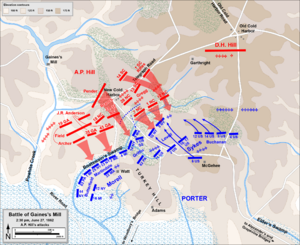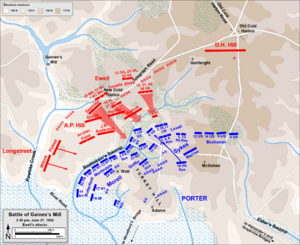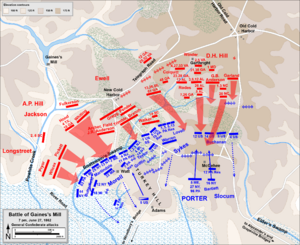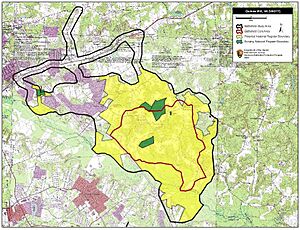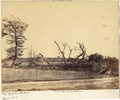Battle of Gaines' Mill facts for kids
Quick facts for kids Battle of Gaines' Mill(First Battle of Cold Harbor) |
|||||||
|---|---|---|---|---|---|---|---|
| Part of the American Civil War | |||||||
 Battle of Friday on the Chickahominy Alfred R. Waud, artist, June 27, 1862 |
|||||||
|
|||||||
| Belligerents | |||||||
| Commanders and leaders | |||||||
| George McClellan Fitz John Porter |
Robert E. Lee | ||||||
| Units involved | |||||||
| Army of the Potomac | Army of Northern Virginia | ||||||
| Strength | |||||||
| 34,214 | 57,018 | ||||||
| Casualties and losses | |||||||
| 7,337 (1,005 killed, 3,107 wounded, 3,236 missing or captured) |
7,993 (1,483 killed, 6,402 wounded, 108 missing or captured) |
||||||
The Battle of Gaines' Mill happened on June 27, 1862, in Hanover County, Virginia. It was the third of the Seven Days Battles during the American Civil War. These battles were part of the Peninsula Campaign, where the Union Army tried to capture Richmond, the Confederate capital.
After a battle the day before, Confederate General Robert E. Lee attacked the Union Army's right side. This part of the Union Army was led by Brig. Gen. Fitz John Porter and was somewhat cut off north of the Chickahominy River. Porter's troops had a strong defense line behind Boatswain's Swamp.
Lee's army launched a huge attack with about 57,000 soldiers. Porter's V Corps, even with some help, held their ground for most of the afternoon. The Confederates attacked in a disorganized way at first, suffering many losses. Later, Confederate General Stonewall Jackson's troops finally arrived.
As evening came, the Confederates made a strong, coordinated attack. They broke through Porter's lines and pushed his men back towards the Chickahominy River. The Union soldiers then crossed the river during the night. The Confederates were too disorganized to chase them. The victory at Gaines' Mill saved Richmond for the Confederacy in 1862. This defeat convinced Union commander George B. McClellan to stop his advance on Richmond and retreat to the James River.
Contents
Why the Battle Happened
The Armies' Positions
By May 1862, Union General George B. McClellan and his Army of the Potomac were very close to Richmond, the Confederate capital. But their advance had stopped after the Battle of Seven Pines. Confederate General Robert E. Lee wanted to take action. He believed staying on defense would weaken the Confederacy.
Lee planned to move his 90,000 Confederate soldiers north of Richmond. He wanted to attack McClellan's right side, which was open and unprotected. Confederate cavalry, led by J.E.B. Stuart, had ridden around McClellan's army. This ride confirmed that the Union flank was indeed vulnerable.
Lee's plan was to have Stonewall Jackson's troops, who arrived by train from the Shenandoah Valley, attack McClellan's right and rear. Meanwhile, other parts of Lee's army would attack from the direction of Mechanicsville.
The Seven Days Battles started on June 25 with a small Union attack. But the first big battle was on June 26, when Lee attacked at the Battle of Beaver Dam Creek. Lee attacked Porter's V Corps north of the Chickahominy River. Most of the Union Army was south of the river and not very busy.
Even though the Union won this battle, McClellan realized he couldn't keep Porter's troops there. Jackson's forces were threatening his side. So, McClellan ordered Porter to retreat. At the same time, he decided to move the army's supply base. It would move from White House on the Pamunkey River to Harrison's Landing on the James River. This decision was a big mistake for McClellan's plan. By leaving the railroad, he couldn't bring the heavy cannons needed to attack Richmond.
Some of McClellan's officers wanted him to attack the Confederate division south of the Chickahominy. But McClellan was afraid of the large number of Confederates he thought were there. He didn't use his actual advantage on that side. The Confederate general, John B. Magruder, helped trick McClellan. He ordered small groups of soldiers to move around noisily. He also used groups of slaves with drums to make it sound like large armies were marching.
The Union Army also had observation balloons. But now, the Confederates had one too! This balloon was made of colorful dress silk. It was tied to a train car and flown by Maj. Edward Porter Alexander. Seeing this Confederate balloon made McClellan even more worried about an attack on his left side. For the second day, the Confederates successfully fooled McClellan south of the river. They used small attacks to keep 60,000 Union soldiers busy. Meanwhile, the real fighting was happening north of the river.
Porter's corps received the order to retreat just before dawn. They didn't have enough time to set up a strong rear guard. This led to many men from Brig. Gen. George A. McCall's division being captured. Porter chose a new strong defensive line. It was on a hill behind Boatswain's Swamp, near Dr. William F. Gaines's mill.
His two divisions were set up in a half-circle. Brig. Gen. George W. Morell was on the left, and Brig. Gen. George Sykes was on the right. Two other divisions were kept in reserve. One was Brig. Gen. George A. McCall's. The other was Brig. Gen. Henry W. Slocum's, who was helping Porter from the VI Corps. Slocum's division had not crossed the river when the battle started. McClellan was worried about an attack on another part of his army.
Lee's attack plan for June 27 was similar to the day before. He would use A.P. Hill's and Longstreet's divisions to push Porter's corps as it retreated. Stonewall Jackson, with D.H. Hill's help, would attack Porter's right side and rear. All of Lee's forces together would make the largest Confederate attack of the war. It involved about 57,000 men in six divisions. Lee met with Jackson to explain the plan. Jackson was supposed to march to Old Cold Harbor, then south beyond Porter's side. However, Lee made a mistake about where Porter's troops were. He thought Porter would defend a line further west than his actual location.
The Battle Begins
The battle started between noon and 1 p.m. on June 27. D.H. Hill's division reached Old Cold Harbor, where they were supposed to meet Stonewall Jackson. Hill sent two brigades forward. They were surprised to find Union infantry fire. He brought up cannons, but they were quickly outmatched by Union cannons. Hill was surprised by the strong resistance. He also realized he was facing the front of the Union force, not its side. So, he decided to wait for Jackson to arrive. The noise from this fight did not reach General Lee's headquarters.
A.P. Hill's division had crossed Beaver Dam Creek early that morning. They found the old Union line was not well defended. As they moved east toward Gaines' Mill, Porter asked McClellan for Slocum's division to cross the Chickahominy and help him. Hill ordered the brigades of Maxcy Gregg and Lawrence O'Bryan Branch to lead the attack. These brigades had not fought the day before and were rested.
Gregg's advance was slowed by Union sharpshooters. By early afternoon, he met strong resistance from Porter's troops along Boatswain's Creek. The swampy ground made it very hard to advance. A very bloody fight happened when the 1st South Carolina Rifles attacked a Union cannon battery. They were pushed back by the Zouaves of the 5th New York. The South Carolinians lost 57% of their men, the most of any Confederate regiment that day. Branch's brigade also suffered heavily, losing 401 men in two hours. Other brigades also attacked but couldn't break the Union lines. Some of Gregg's men reached the other side of the creek, but most did not.
Instead of chasing a retreating enemy, A.P. Hill attacked a strong Union position. He lost about 2,000 of his 13,200 men in this failed attempt. With his attacks from the day before, his division had lost over a quarter of its men. General McClellan felt good about the messages Porter sent him. He told Porter to "pitch in" if the enemy was retreating. He also told another general to attack the enemy's side if he saw a chance. But McClellan was upset to hear that this general had destroyed a bridge, fearing an enemy attack. McClellan's optimism disappeared, and he ordered his headquarters to pack up for a retreat.
On the Confederate side, General Lee was very involved in the failed attack. He was rallying his troops too close to the front lines. When Longstreet arrived, he saw how hard it was to attack over such ground. He decided to wait until Stonewall Jackson could attack from Hill's left.
Jackson's Delayed Arrival
For the second time in the Seven Days Battles, Jackson was late. A guide led him down the wrong road, causing about an hour's delay. Then, Jackson's troops found the road blocked by trees cut down by the retreating Union army. They were also bothered by Union sharpshooters.
The first of Jackson's troops to reach the battlefield was Maj. Gen. Richard S. Ewell's division. Lee's aide told Ewell to attack right away. Lee was worried Porter might counterattack A.P. Hill's tired troops. So, he ordered Longstreet to make a fake attack to hold the lines until Jackson's full force arrived. In Longstreet's attack, Brig. Gen. George E. Pickett's brigade tried a direct attack. They were pushed back with heavy losses. Pickett himself was shot in the shoulder and couldn't fight for the rest of the summer. Confederate President Jefferson Davis watched Pickett's failed attempt.
Ewell began his attack around 3:30 p.m., without waiting for all his troops. General Lee told him to attack along the same path Gregg and Branch had used. Ewell sent in his lead brigade, but they got lost in the woods and swamps. Their confusion grew when their commander was killed. Another brave leader, Maj. Roberdeau Wheat, also died. Ewell's attack continued, but his troops couldn't get past the swamp.
Porter was starting to get reinforcements from Slocum's division. He used these new troops to fill gaps in his line. However, even though Porter asked for more help, General McClellan didn't think about a counterattack. He asked his generals south of the river if they could spare any troops. When no one volunteered, he ordered two brigades to cross the river. But they wouldn't arrive for another three hours.
When Stonewall Jackson finally reached Old Cold Harbor, he was tired from all the marching. He started to get his troops ready to trap the Union soldiers. But mistakes by his staff kept his men from moving forward for over an hour. Lee met Jackson and showed his frustration about the delay. Jackson replied that his troops could "stand anything."
The Final Confederate Attack
Lee's big attack at 7 p.m. involved 16 brigades, about 32,100 men. Porter had about 34,000 men defending the line. But many of them were tired from earlier attacks. Also, new reinforcements were just thrown into the line, making it harder to fight together. Still, the Union had good defensive ground and more cannons.
The Confederates couldn't attack all at once in a perfect line. They rushed forward in smaller groups and were pushed back many times. On the Confederate left, D.H. Hill sent in almost his whole division. But they met strong resistance from George Sykes's Union regulars.
In the center, a large new Confederate brigade attacked. They pushed forward with help from other brigades. Many Confederate officers were killed or wounded in this attack. On the Confederate right, the ground was very difficult. There was an open wheat field that sloped down to Boatswain's Swamp. Beyond the swamp were two lines of Union defenders on higher ground. Longstreet ordered Pickett's brigade to attack again, supported by other brigades. Longstreet later wrote that he was "in the position from which the enemy wished us to attack him."
As the sun set, William Whiting's division finally broke through the Union line. Brig. Gen. John Bell Hood's Texas Brigade charged forward aggressively and made a hole in the line. Many officers in Whiting's brigades were killed or wounded. Pickett's brigade also succeeded in its second attack.
The Confederate breakthroughs in the center and right could not be stopped. The Union line fell apart. Nine Union regimental commanders were killed or badly wounded. Many Union soldiers were surrounded and captured. Sykes's regulars retreated in an orderly way. Two Union brigades arrived too late to help fight, but they did protect Porter's retreat. A small group of Union cavalry made a desperate charge but had to surrender. By 4 a.m. on June 28, Porter had crossed the Chickahominy River, burning the bridges behind him. During the retreat, Brig. Gen John F. Reynolds was captured while sleeping.
Aftermath of the Battle
Gaines' Mill was a very intense battle. It was the largest of the Seven Days Battles and the only clear Confederate victory. The Union Army had 34,214 soldiers fighting. They suffered 6,837 casualties (894 killed, 3,107 wounded, and 2,836 captured or missing). The Confederates had 57,018 soldiers fighting. They lost 7,993 men (1,483 killed, 6,402 wounded, and 108 missing or captured). This included three brigade commanders and one general officer. The Union Army lost no general officers killed or wounded.
Since the Confederate attack was only against a small part of the Union Army (Porter's V Corps), the Union Army was still in pretty good shape overall. Lee's victory, his first of the war, could have been even more complete. This was because of mistakes made by Stonewall Jackson. Some historians believe that if Jackson had attacked earlier, the main Confederate assault could have happened three or four hours sooner. This would have put Porter in great danger, without any last-minute help or the cover of darkness.
Even though McClellan had already planned to move his supply base, his defeat at Gaines' Mill made him very nervous. He quickly decided to stop his advance on Richmond. He began to retreat his entire army to the James River. Gaines' Mill and the Union retreat across the Chickahominy was a big win for the Confederacy. It showed that Richmond was safe for now.
Battlefield Preservation
For almost 150 years, only a small part of the Gaines' Mill battlefield was protected. This was a 60-acre section around the Watt House, managed by the National Park Service. This is only a tiny piece of the more than 2,000 acres that make up the battlefield.
In 2011, two new efforts helped preserve more land. The Richmond Battlefields Association and the American Battlefield Trust helped protect a new 285-acre area. This area is called the "Longstreet Attack" tract. It greatly increased the amount of protected land at Gaines' Mill. The American Battlefield Trust and its partners have now saved a total of 932 acres (3.77 km2) of the battlefield.
Images for kids
-
"Virginia, Cold harbor extreme Line of Confederate Works" An April 1865 John Reekie photograph
-
An April 1865 John Reekie photograph of the Ruins of Gaines' Mill showing remains of a soldier's grave in the foreground
See also
 In Spanish: Batalla de Gaines's Mill para niños
In Spanish: Batalla de Gaines's Mill para niños




